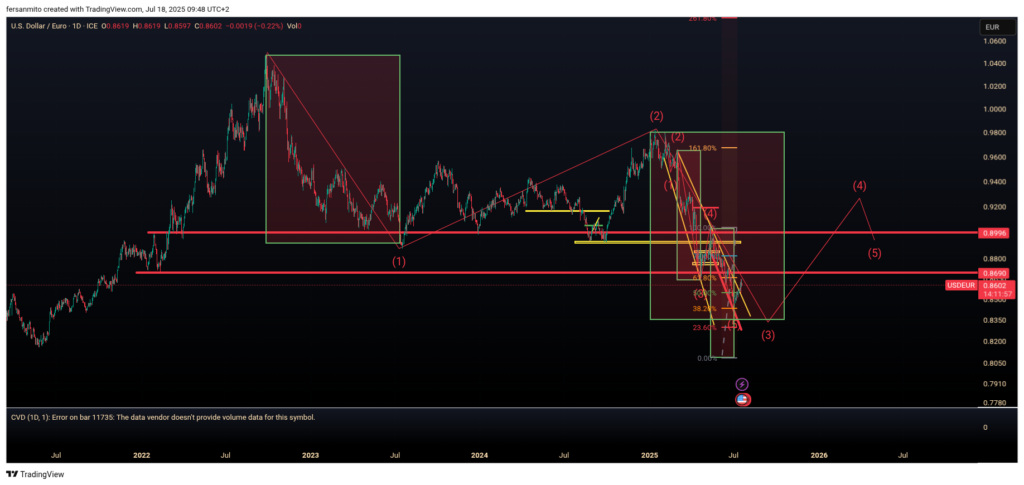
📈 Elliott Wave Analysis: A Double Matryoshka Structure
In this chart, I’m applying Elliott Wave Theory to the USD/EUR pair, and my approach is based on two “Matryoshka” structures — one large and one nested inside it. The major impulsive wave (from the 2022 top) appears to have completed wave (1), followed by a corrective (2), and we are now deep into the heart of wave (3).
I always use the principle that wave 1 is often similar to wave 5, unless wave 3 is significantly extended. In this case, wave (3) has clearly gone beyond the 161.8% Fibonacci extension, confirming strong bearish momentum. If this structure continues, wave (5) could also develop proportionally, potentially reaching new lows.
In the short-term fractal (inner Matryoshka), we seem to be forming the last legs of wave (3), and I’m now watching closely for a corrective wave (4), possibly targeting the 0.8690–0.8996 zone. After that, I’d expect a final impulse down as wave (5).
💱 Dollar Weakness in a World of All-Time Highs – What’s Going On?
Now let’s go beyond the chart, because something doesn’t quite add up.
We’re in one of those rare moments where nearly all risk assets are printing new all-time highs:
- Bitcoin surged past $122,000
- Nvidia broke $4 trillion market cap
- Nasdaq and S&P 500 are at record levels
And yet… the U.S. dollar is collapsing against the euro.
That’s not normal. Usually, when risk assets rise, it signals economic strength, capital inflows, and often a strong dollar. But this time, the dollar is behaving like we’re in the middle of a crisis or a global shock — and that contradiction is at the heart of my concern.
Here’s my view:
🔻 A weak dollar helps the U.S. sell basic goods, yes. But it hurts its leadership in high-tech sectors. When you try to sell AI chips, semiconductors, or software globally, a weak dollar erodes pricing power and profitability.
💥 For the average U.S. citizen, it also means imported inflation, lower purchasing power, and a long-term erosion of trust in the economy — especially with the massive U.S. deficit looming over the bond market.
🛡️ Military and defense exports may benefit temporarily — especially in today’s geopolitical context — but with Trump threatening 30% tariffs on EU goods, and Canada responding with its own, trade friction could spiral out of control.
From my point of view, if you’re an investor, you have to ask:
Why would I buy U.S. bonds if I’ll lose 5–10% just on currency depreciation?
📌 Conclusion: Technical Setup vs Macro Paradox
Technically, the USD/EUR chart is clear: a bearish Elliott Wave setup with room for another leg down.
But fundamentally? The dollar is too weak, considering the strength of U.S. assets.
That paradox — strong markets with a weak dollar — suggests something is broken beneath the surface. It could be excessive Fed liquidity expectations, a loss of confidence in long-term U.S. fiscal discipline, or just a crowded macro trade.
In the short term, I’ll continue trading the chart. But in the medium term, I’m preparing for a potential revaluation of the euro, or at least a stabilization. This is not a time to blindly follow the momentum — it’s a time to ask what’s real and what’s purely driven by liquidity and positioning.